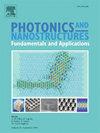Numerical investigations of spin-multiplexing perfect vortex beam generator via dielectric metasurface at telecommunication wavelengths
IF 2.9
3区 物理与天体物理
Q3 MATERIALS SCIENCE, MULTIDISCIPLINARY
Photonics and Nanostructures-Fundamentals and Applications
Pub Date : 2025-02-01
DOI:10.1016/j.photonics.2025.101361
引用次数: 0
Abstract
The ring structure radius of a perfect vortex beam (PVB) is invariant to topological charge, offering promising applications in optical communication, particle manipulation, and quantum optics. Integration of PVBs into on-chip optics remains challenging because complex and bulky optical devices are conventionally applied to generate PVBs. This paper reports that PVBs at telecommunication wavelengths can be generated through phase modulation in a single dielectric metasurface. The metasurface enables to generate PVBs with two distinct topological charges under orthogonal circular polarization illumination by employing a spin-multiplexing design strategy. Numerical simulations demonstrate that the radius of a PVB can be manipulated by modifying the structural parameters of the designed metasurface with high design flexibility. Further modulation of the polarization state of the incident light allows for the linear superposition of two PVBs with orthogonal circular polarization states to create a perfect Poincaré beam (PPB), which is characterized by a vectorial optical field on a higher-order Poincaré sphere. Our results introduce a straightforward method to develop versatile nanophotonic platforms for complex structured light generation and polarization engineering.
电信波长介质超表面自旋复用完美涡旋光束发生器的数值研究
完美涡旋光束的环形结构半径不随拓扑电荷的变化而变化,在光通信、粒子操纵和量子光学等领域具有广阔的应用前景。将pvb集成到片上光学器件中仍然具有挑战性,因为传统上使用复杂而笨重的光学器件来生成pvb。本文报道了在单介质超表面上通过相位调制可以产生电信波长的pvb。通过采用自旋复用设计策略,该超表面能够在正交圆偏振照明下生成具有两种不同拓扑电荷的pvb。数值模拟结果表明,通过改变所设计的超表面的结构参数,可以实现对PVB半径的控制,具有较高的设计灵活性。进一步调制入射光的偏振态,可以使两个正交圆偏振态的pvb线性叠加,从而产生一个完美的庞卡罗莱光束(PPB),其特征是在高阶庞卡罗莱球上有一个矢量光场。我们的研究结果为开发用于复杂结构光产生和偏振工程的多功能纳米光子平台提供了一种简单的方法。
本文章由计算机程序翻译,如有差异,请以英文原文为准。
求助全文
约1分钟内获得全文
求助全文
来源期刊
CiteScore
5.00
自引率
3.70%
发文量
77
审稿时长
62 days
期刊介绍:
This journal establishes a dedicated channel for physicists, material scientists, chemists, engineers and computer scientists who are interested in photonics and nanostructures, and especially in research related to photonic crystals, photonic band gaps and metamaterials. The Journal sheds light on the latest developments in this growing field of science that will see the emergence of faster telecommunications and ultimately computers that use light instead of electrons to connect components.

 求助内容:
求助内容: 应助结果提醒方式:
应助结果提醒方式:


